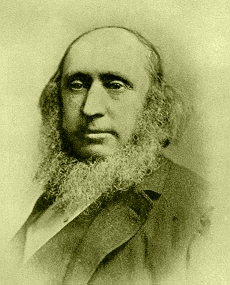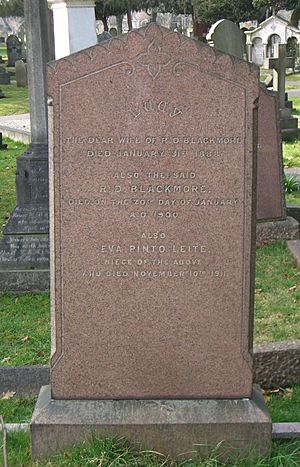R. D. Blackmore facts for kids
Quick facts for kids
R. D. Blackmore
|
|
|---|---|

R. D. Blackmore was one of the most famous English novelists of his generation.
|
|
| Born | 7 June 1825 Longworth, Berkshire (now Oxfordshire), England |
| Died | 20 January 1900 (aged 74) Teddington, Middlesex, England |
| Occupation | novelist, horticulturist |
| Literary movement | Romantic |
| Notable works | Lorna Doone |
Richard Doddridge Blackmore (born June 7, 1825 – died January 20, 1900), known as R. D. Blackmore, was a very famous English writer in the late 1800s. People loved his books because he described the countryside so well. He made the natural world feel alive in his stories. Like Thomas Hardy, Blackmore often wrote about Western England. His stories had a strong sense of place.
Blackmore is sometimes called the "Last Victorian" writer. He helped start a new style of fiction that later writers like Robert Louis Stevenson followed. People described him as proud, shy, and strong-willed, but also sweet-tempered. Even though he wrote many books, only his novel Lorna Doone is still popular today.
Contents
Richard Doddridge Blackmore's Life
Richard Doddridge Blackmore was born on June 7, 1825. His birthplace was Longworth in Berkshire, which is now part of Oxfordshire, England. His father, John Blackmore, was a church leader there. Richard's mother died just a few months after he was born. She passed away because of a sickness called typhus that spread in the village.
After this sad event, his father moved to different places in Devon. Richard, however, went to live with his aunt, Mary Frances Knight. When his aunt married, they moved to a rectory near Oxford. In 1831, Richard's father married again, and Richard returned to live with him. Richard spent much of his childhood in the beautiful "Doone Country" of Exmoor. This area, with its lovely Badgworthy Water, is where he later set his most famous book. He grew to love this countryside deeply, and it became a big part of his writing.
School and University
In 1837, Blackmore started attending Blundell's School in Tiverton. He was very good at studying old languages like Latin and Greek. Later, he won a special scholarship to Exeter College at the Oxford. He finished his degree there in 1847.
During a break from university, he tried writing his first novel. This was the start of The Maid of Sker. He didn't finish it until many years later, and it was published in 1872. Blackmore himself thought this book was his best work.
After leaving Oxford, Blackmore worked as a private teacher for a while. Then, he decided to become a lawyer. He began studying law in 1849 and became a lawyer in 1852. But he had health problems that stopped him from working as a full-time lawyer. So, in 1854, he became a classics teacher at a school in Twickenham. Soon after, he moved from London to Hampton Wick. He lived there until he moved to his new home in Teddington.
His Marriage
Blackmore married Lucy Maguire on November 8, 1853. The wedding took place at Trinity Church in Holborn. Lucy was 26 years old and a Roman Catholic. She was also quite delicate, which is thought to be why they never had children. They both loved Lucy's sister Agnes's four children very much. The children often stayed with them. The Blackmores even seemed to adopt one of the nieces, Eva, when she was seven. Blackmore's sister said they had a "happy marriage."
Moving to the Countryside
In September 1857, Blackmore's uncle passed away. His uncle left him some money. This money helped Blackmore achieve a dream he had for a long time: owning a house in the countryside with a big garden. Blackmore's father encouraged him and helped him make this dream come true.
Growing Fruit for Business
Blackmore chose a large piece of land, about 16 acres, in Teddington. He had admired this land for some time. He built his new house there, which was finished in 1860. He lived in this house for the rest of his life. He named it Gomer House after one of his favorite dogs. In the large garden, he created an 11-acre farm. He specialized in growing fruit to sell. High walls surrounded the garden. These walls helped keep out thieves and helped tender fruits ripen.
Blackmore knew a lot about growing plants. However, his fruit business was not very profitable. This was due to competition and other reasons. Still, he was very proud of his gardening. He even believed he would rather be remembered for winning a prize for growing vegetables than for writing Lorna Doone.
Protecting the Environment
When Blackmore first moved to Teddington, it was a quiet, rural area. But soon, there were plans to buy land and build railway lines. In 1868, Blackmore successfully fought against the London and South Western Railway Company. They wanted to take some of his property. However, he could not stop them from building a railway station. The station ended up being almost directly across from his house.
His Books, Fame, and Death
Blackmore started his writing career by publishing poetry. Then, he began writing novels. His third novel, Lorna Doone (published in 1869), became his most famous and successful book. It made him one of the top British novelists of his time. With this book, he helped start a new romantic style in English stories.
Lorna Doone's huge popularity came when it was released as a single book. It had not been very successful when it was first published in three separate volumes. Blackmore thought the book became popular by accident. A book reviewer wrongly said the story was about the ancestors of Lord Lorne. Lord Lorne had recently married Princess Louise, making the book seem more interesting to people.
Thomas Hardy, another famous writer, wrote to Blackmore to say he liked the book. But the two writers also had some friendly competition. There were several attempts to turn Lorna Doone into a play. Blackmore only approved one, which was written by Horace Newte.
Blackmore often set his characters against important historical events. He followed the style of Sir Walter Scott in this way. For example, his book Springhaven (1887) was set during the Napoleonic Wars. Many people thought his descriptions were even better than his story plots.
Some people in Teddington thought Blackmore was a bit unsociable. A local merchant once said that Blackmore was "wedded to his garden in summer and his book writing in winter." He also mentioned that Blackmore kept "vicious dogs" to protect his fruit. This description might make Blackmore seem unfriendly. However, even though he was a private person, he had many close friends. He was also busy with his writing and fruit growing. His books were very popular in the United States, and he made many friends with Americans during his life.
Blackmore's wife, Lucy, became very ill in early 1888. She passed away at the end of that month. Her funeral was held on February 3, 1888, in Teddington Parish Church. She was buried in Teddington Cemetery. After her death, Blackmore was cared for by her nieces, Eva and Adalgisa Pinto-Leite.
Blackmore died in Teddington on January 20, 1900. He had been sick for a long time. He was buried next to his wife, just as he had wished. His last letter was to his sister Ellen, who was also very ill. In his short Christmas letter of 1899, Blackmore wrote:
"I have fallen away during the last month, having taken obstinate chills, & caring neither to eat nor drink, nor speak. All my energy & spirit are abated, & often I know not where I am. – E. & D. join me in kindest love, & I am always"
"PS Frost coming, I fear – don't like the look of it[.]"
He was 74 years old when he died. Many people attended his funeral at Teddington Cemetery. Four years after his death, in April 1904, a memorial was placed for him in Exeter Cathedral. This memorial was created by a group that included his friend Thomas Hardy, Rudyard Kipling, and James Barrie. Another writer from Devon, Eden Phillpotts, wrote the words for the memorial. A smaller copy of the memorial was also put in Oare Church in Somerset. This is the church where Lorna Doone was married in his famous novel.
What Happened After His Death
Blackmore's two nieces continued to live in Gomer House. Amelia, one of the nieces, died in 1911 and was also buried in the Blackmore family grave. In October 1938, all the items in Gomer House were sold at an auction. This included Blackmore's own library, which had first editions of his books.
The house itself was later torn down. New streets were built in its place, named Doone Close, Blackmore's Grove, and Gomer Gardens. These names remember the novelist's connection to Teddington. Doone Close is roughly where Gomer House used to stand. Blackmore's fruit garden covered the area between today's Station Road and Field Lane.
Blackmore's Books
- Poems by Melanter (1854)
- Epullia and other poems (1854)
- The Bugle of the Black Sea (1855)
- The Fate of Franklin (1860)
- Farm and Fruit of Old: an illustration in verse of the first and second Georgics of Virgil (1862)
- Clara Vaughan: a novel (1864)
- Cradock Nowell: a tale of the New Forest (1866)
- Lorna Doone: a romance of Exmoor (1869)
- The Maid of Sker (1872)
- Alice Lorraine: a tale of the South Downs (1875)
- Cripps the Carrier: a woodland tale (1876)
- Erema; or, my father's sin (1877)
- Mary Anerley: a Yorkshire tale (1880)
- Christowell: a Dartmoor tale (1882)
- Sir Thomas Upmore (1884)
- Springhaven: a tale of the Great War (1887)
- Kit and Kitty: a story of west Middlesex (1890)
- Perlycross: a tale of the western hills (1894)
- Fringilla: a tale in verse (1895)
- Tales from a Telling House, or Slain by the Doones: four short stories (1895)
- Dariel: a romance of Surrey (1897)
- Uncollected Story: Leila, the Golden Fleece. (1896, 29 Nov & 6 Dec), in The Daily News, Denver, Colorado, and other US newspapers on these and later dates.
Images for kids
See also
 In Spanish: Richard Doddridge Blackmore para niños
In Spanish: Richard Doddridge Blackmore para niños




